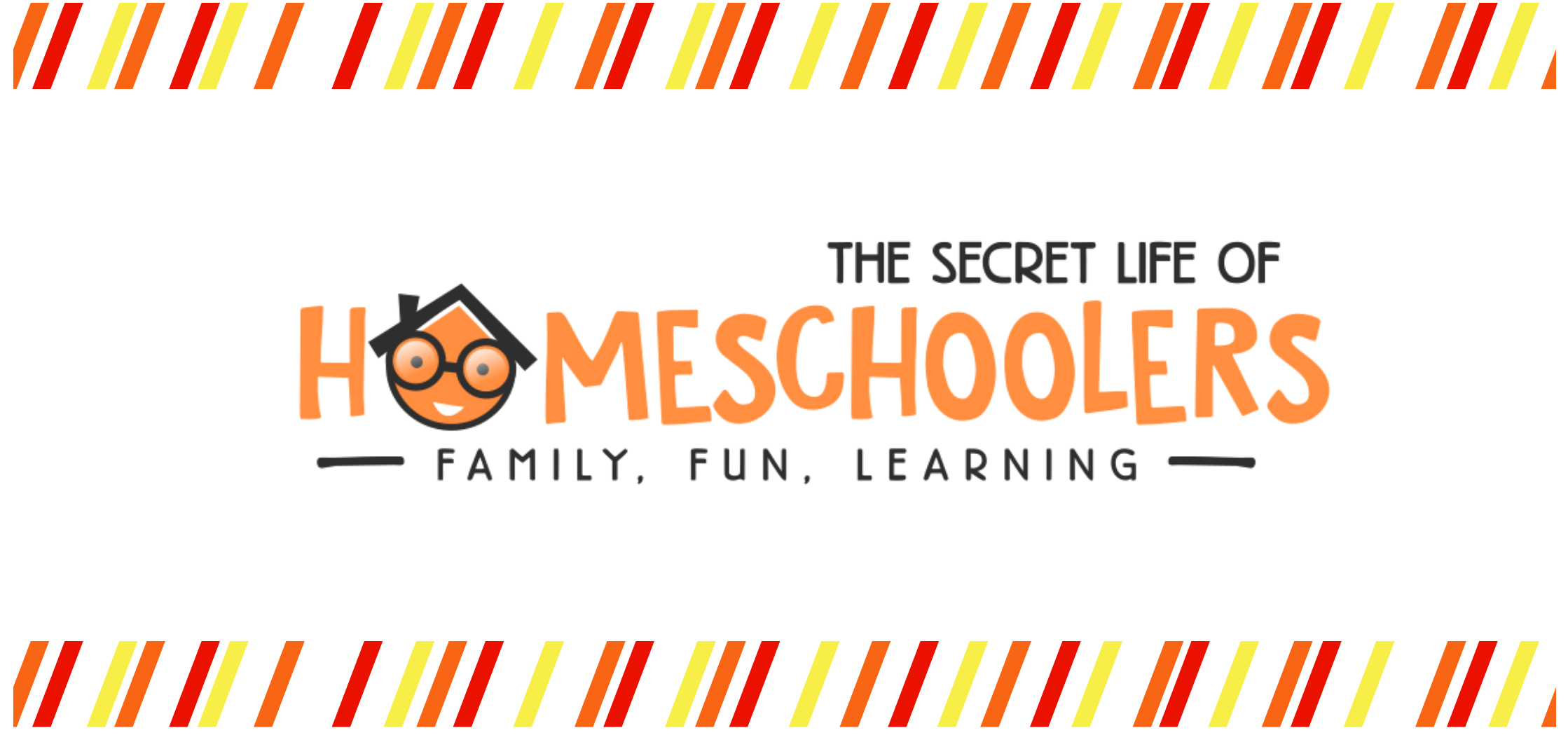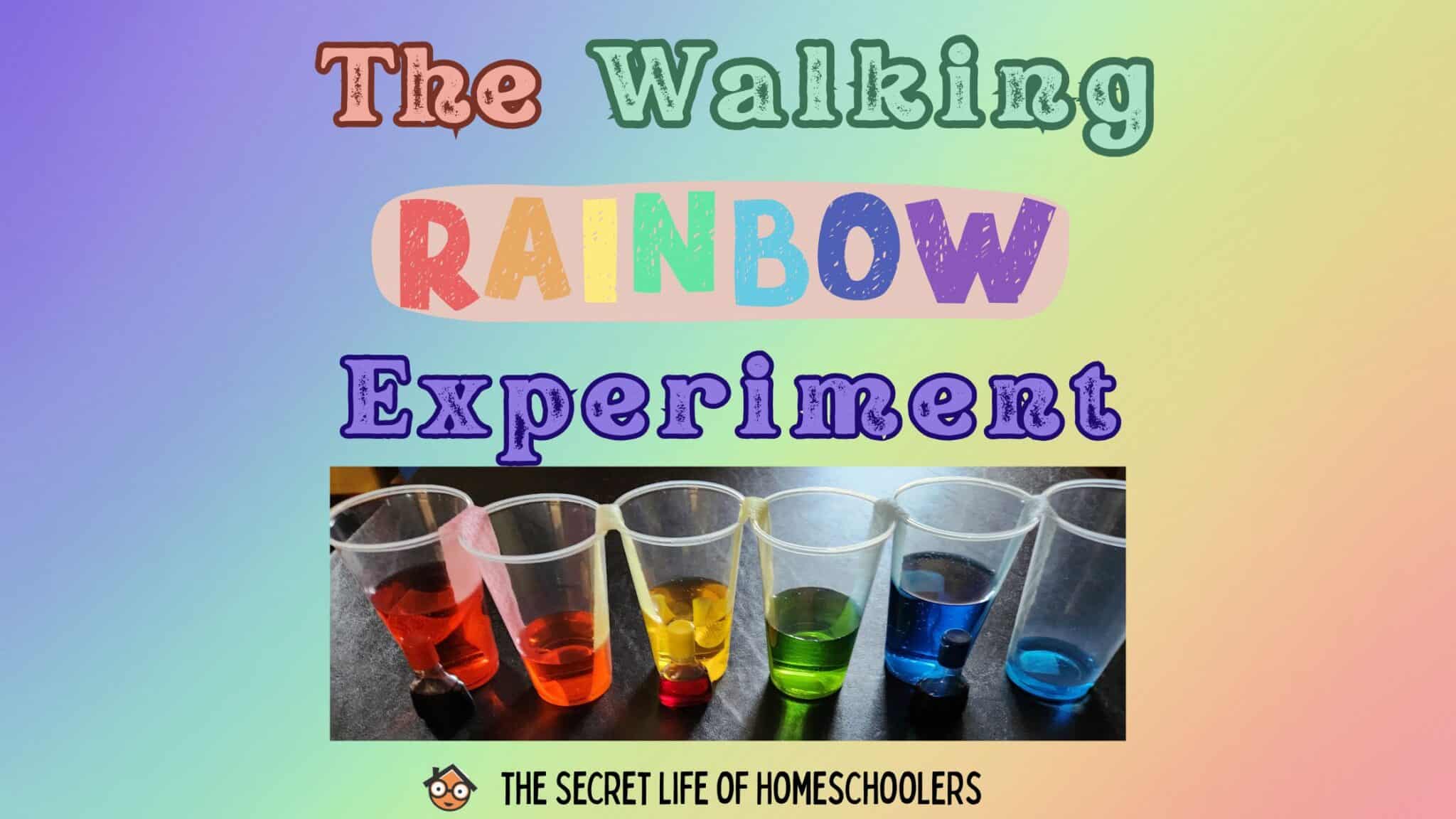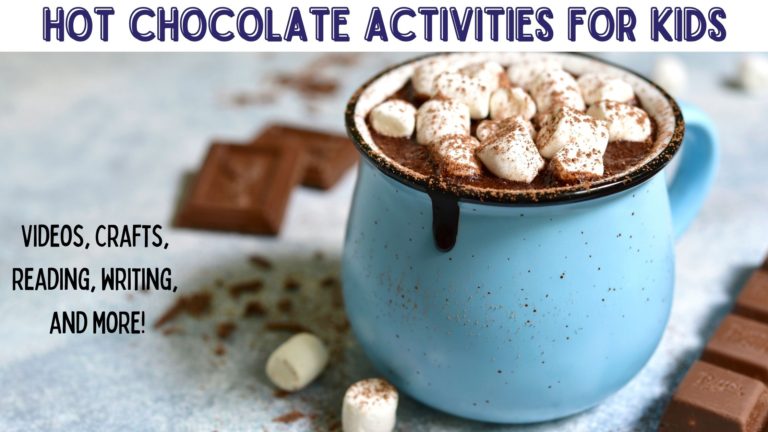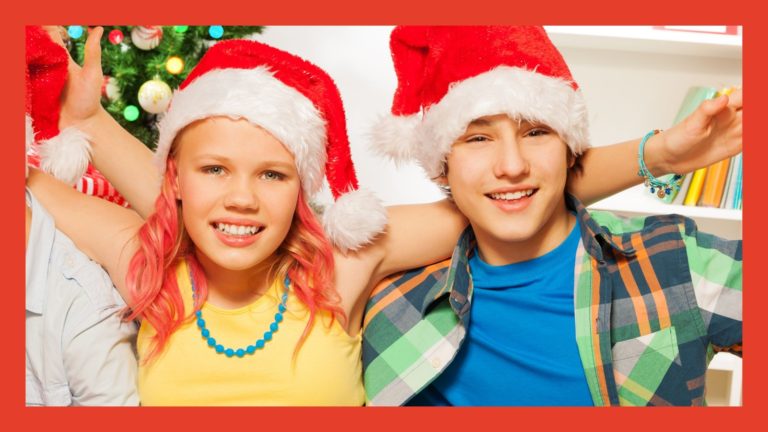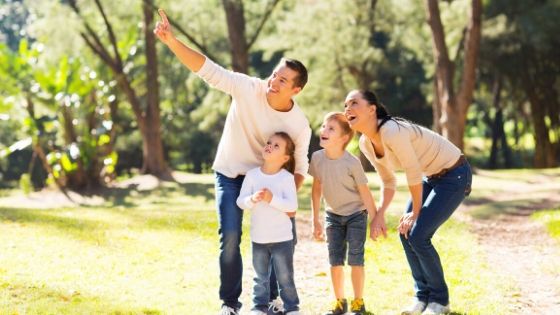Looking for a colorful, mess-free science activity that feels like magic? This rainbow science experiment is just what you need to brighten up your homeschool day or classroom lesson. It’s super simple, fun for all ages, and teaches kids how water moves in a way they can actually see. Plus, the little ones learn about color theory.
The best part? It only takes a few supplies and about 30 minutes of waiting time to start seeing results, which gives you a chance to talk, play, or read while the rainbow forms.
What Is the Walking Rainbow Science Experiment?
The walking rainbow science experiment uses paper towels to move colored water from one cup to another. As the colors travel, they meet in empty cups and mix to form new colors just like magic! But there’s also real science happening behind the scenes.
This is a great hands-on way to explore color mixing, water movement, and patience all in one easy experiment.
So, let’s get started!
Table of Contents
- What Is the Walking Rainbow Science Experiment?
- Super Simple Walking Rainbow
- Great for All Ages
- Tips for a Successful Rainbow Experiment
- Extend Your Learning
- The Science Behind the Walking Rainbow Science Experiment
- Why This Experiment Matters
- Ready to Try This Fun Walking Rainbow Science Experiment?!
Super Simple Walking Rainbow
You probably already have everything you need at home or in the classroom to do this experiment! This activity really is that simple.
Supplies Need
- 6 clear cups or jars (plastic or glass)
- Warm water
- Red, yellow, and blue food coloring
- Paper towels (cut larger sheets into 1-2 inch strips)
- A table for your setup
That’s it! No glue, no batteries, and no mess (hopefully).
Set Up Your Rainbow
Fortunately, setting up this experiment is pretty simple. Kids of all ages can help. I would have used this as an opportunity for my preschoolers to practice pouring using little water pitchers (see pictures below). When I owned a preschool and daycare, we did a lot of Montessori activities, such as pouring.
For the setup, you:
- Line up the six cups in a row. (Or in a circle if you want the color purple)
- Fill the 1st, 3rd, and 5th cups halfway to three-quarters with water.
- Add red food coloring (5-10 drops) to the 1st cup, yellow to the 3rd, and blue to the 5th. Stir gently until mixed.
- Leave the 2nd, 4th, and 6th cups empty.
- Fold the paper towels into strips and place them so one end sits in a full cup and the other in an empty cup beside it.
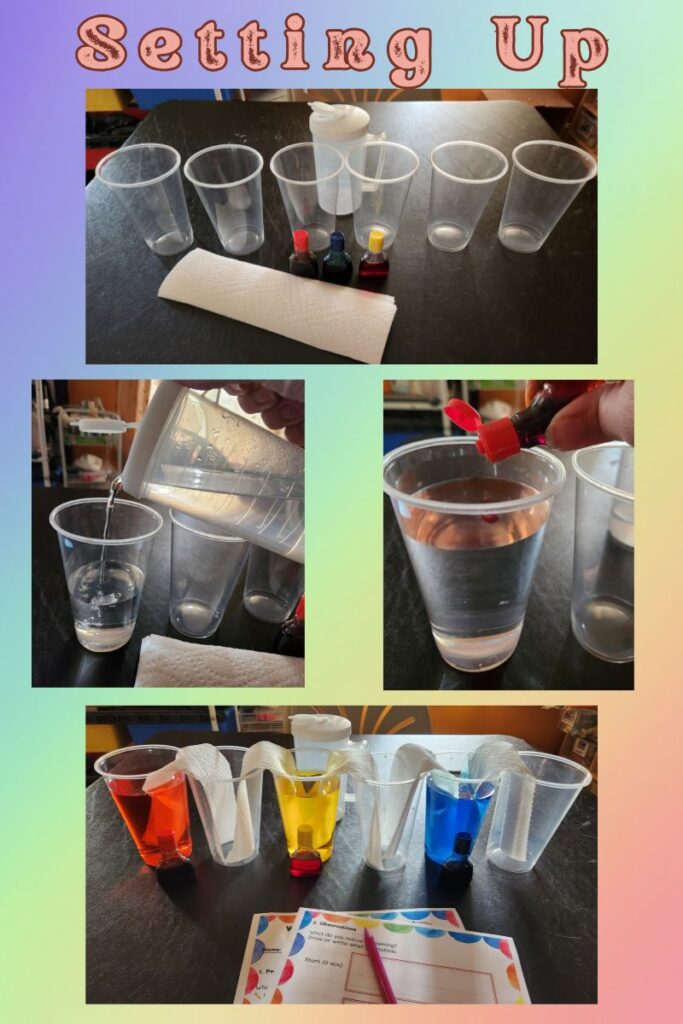
Now the waiting begins!
While you wait, you can discuss what they think will happen and why. Jot down the kids’ answers, if doing it with younger kids or a group, so that they can compare them at the end.
Older kids can record their answers in a journal or use the worksheets I created below.
With your preschool and kindergarten kiddos, you can read some fun books about colors or rainbows while you wait.
What Happens Next?
Over the next 30 minutes or hour (depending on the size of your cups), you’ll see something amazing: the colored water will “walk” up the paper towels and into the empty cups. Soon, the empty cups will start to fill with new colors: orange and green.
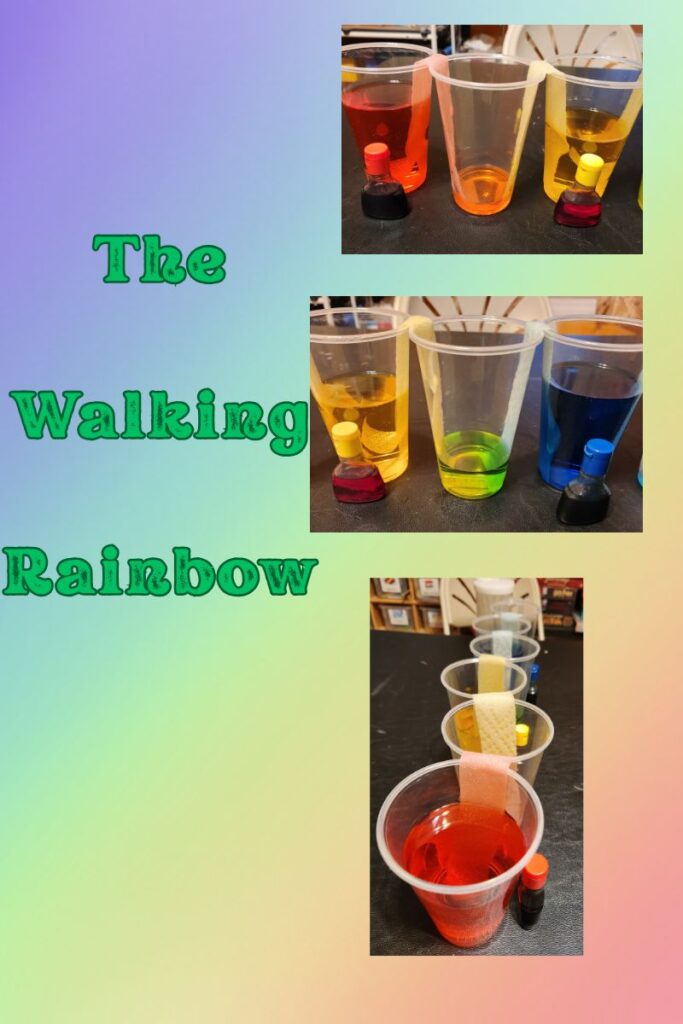
If you want the color purple, set the cups up in a circle, instead of a line, and place a paper towel from the blue into the sixth cup (empty one), and a paper towel from the red into that sixth cup as well.
This is a perfect time for kids to review what they thought would happen and make more accurate predictions.
What will happen when the red and yellow mix? What about blue and yellow? Do they think they’ll mix?
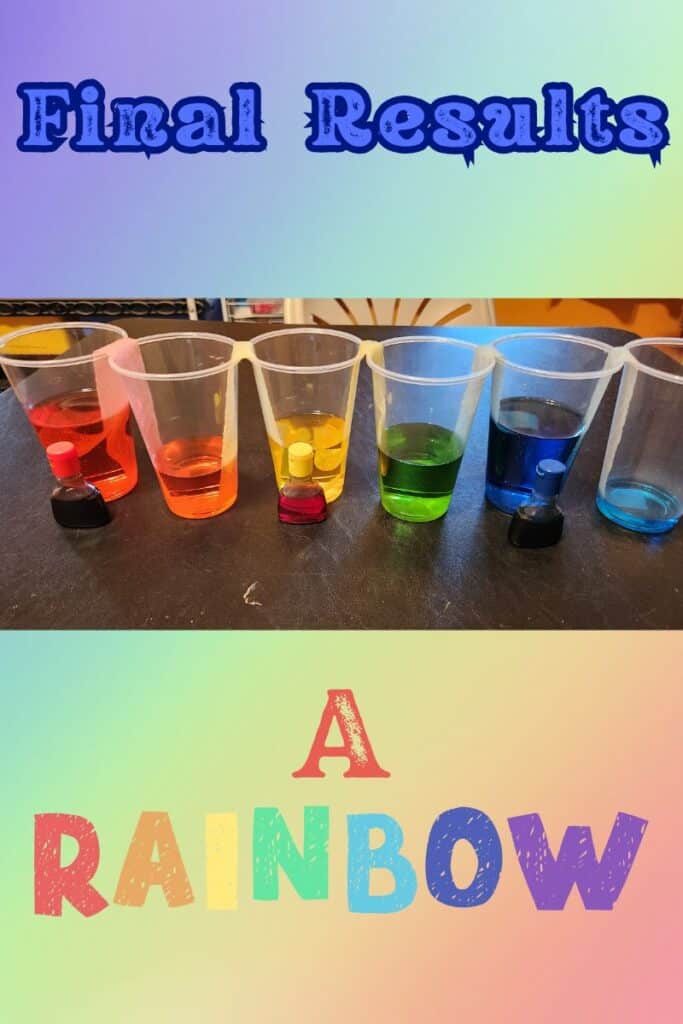
With older kids, especially if they are familiar with what will happen, have them try to figure out the science behind why the water is “walking” up the paper towels. See if they know what science concepts this demonstrates.
If you want a FREE handout with this activity, sign up below, and I’ll deliver it to your inbox. You can unsubscribe anytime.
Great for All Ages
This rainbow science experiment is great for preschoolers through elementary school students. Little ones love the colors and the surprise of new ones forming. Older kids can start to think about why the water moves and what it means for science.
You can even challenge older kids to draw what they think will happen, or turn it into a journal entry or mini science report!
Tips for a Successful Rainbow Experiment
For this experiment to be successful, you’ll want to consider the following tips:
- Use warm water; it travels faster than cold!
- One-inch-wide strips worked better. It took longer with the wider strips.
- Make sure the paper towels are touching the water fully.
- If the paper towels are too thick, try pulling them apart or using thinner paper.
- Smaller cups may work faster than taller cups.
- Be patient. You will start seeing water moving up the paper towel within a few minutes. Within an hour, the water will begin to mix in the cup. It may take several hours for the full results. Again, it depends on the size of your cups and the type of paper towels you use.
If you keep these simple tips in mind, you are more likely to have success. Believe me, we are the masters of failed science experiments. We are actually surprised when things go as planned! That’s why I have a whole article on what to do when science experiments fail.
I made some initial mistakes with this one (I didn’t use warm water 🤦🏻♀️) and had to adjust things to get it to work. I would definitely use smaller cups (such as small mason jars) next time.
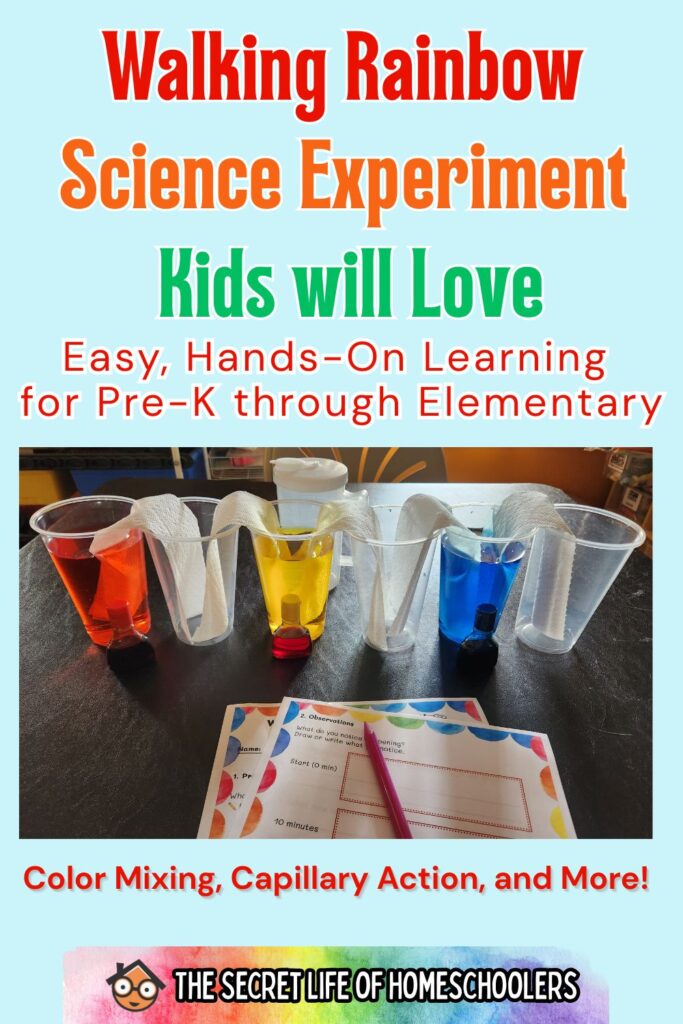
Extend Your Learning
Here are some fun ways to build on this experiment:
- Color Mixing Challenge: Now that kids have seen how colors mix to form new colors, they can use paint (acrylic or watercolor) to intentionally create their own colors.
- Art Link: Use the mixed colors from the previous activity as paint for a rainbow-themed art project!
- Math Connection: Estimate how long it will take for the water to reach the top of the paper towel, then the bottom of the next cup, and when you start seeing the color mix. Record your results and see if they can make better estimations.
- Older kids can figure out the length of time it takes for the colors to transfer from one cup to the next and from the cup to mix the colors. This will help kids learn how to subtract time. Ex. 10:15 a.m. – 9:50 a.m.
More Science:
Colored Carnations: Little kids would love the carnation experiment. Take a white carnation and place it in water with food coloring. They watch the carnations change color as the water moves up them.
Rainbows: You can also talk about rainbows in nature and why they form. Plus, you can look at how light breaks into colors when it passes through water droplets (hello, double rainbow!).
Plant Unit: This science experiment is also a great way to kick off a biology unit on plants. It’s a fantastic way to start a discussion on how plants absorb water and nutrients.
The Science Behind the Walking Rainbow Science Experiment
So, what’s really happening here? What is the science?
The secret is called capillary action. That’s when water moves through tiny spaces, like the fibers of a paper towel, without needing to be poured. The water “climbs” up the towel and carries the food coloring with it.
This is the same way plants get water from the soil. The roots absorb water and pull it up through the stem to feed the whole plant. Your kids are watching that process happen in real time, though, this is with cups and paper towels instead of flowers and dirt!
It seems kind of weird because gravity usually pulls things down, but in this case, the water can climb up because of capillary action.
You’re also seeing absorption, which is how materials soak up liquids. The paper towel acts like a sponge, pulling water from one cup and dripping it into the next.
When two colors meet in the middle cups, you get to explore color mixing as well. Red and yellow make orange, blue and yellow make green, and red and blue make purple. What a great review for learners and fun discovery for preschoolers!
Why This Experiment Matters
It’s a cool experiment and all, but why does it matter? Why should kids care?
The walking rainbow science experiment isn’t just pretty; it’s packed with real learning! This is perfect because when learning is meaningful, kids are more likely to remember it. Plus, they see the value in continually learning new things.
This simple science experiment is excellent because it:
- encourages curiosity
- builds observation skills
- helps children start to understand how water moves in the world around them.
Capillary action occurs every day, from thirsty plants to soaking up spills (try using different materials to soak up spills). Now, your kids have seen it with their own eyes! And they may start to notice it more in the world around them. Only now will they understand the science behind what is happening!
{More Science Fun: Bubble Science Experiment}
Ready to Try This Fun Walking Rainbow Science Experiment?!
Find a little time this week to try this colorful activity. Whether you’re a homeschool mom planning your next science unit or a teacher looking for a quick, low-prep idea, this rainbow science experiment is sure to spark some joy and excitement in learning. After all, it’s the kind of learning that feels like play, just the way science should be.
Happy Homeschooling!
